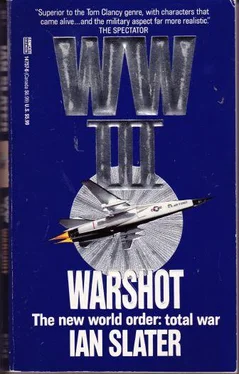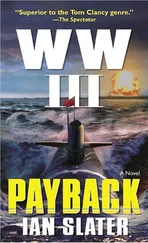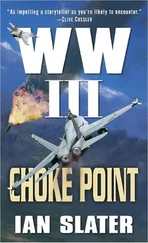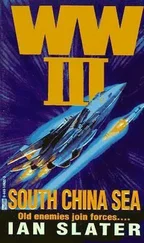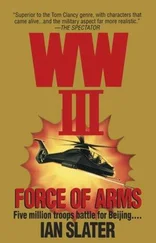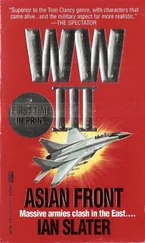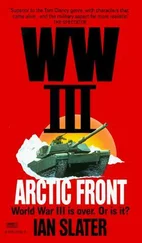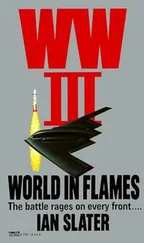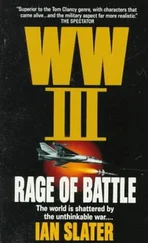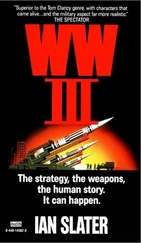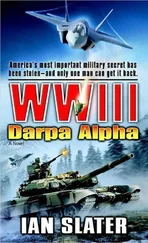Ian Slater - Warshot
Здесь есть возможность читать онлайн «Ian Slater - Warshot» весь текст электронной книги совершенно бесплатно (целиком полную версию без сокращений). В некоторых случаях можно слушать аудио, скачать через торрент в формате fb2 и присутствует краткое содержание. Год выпуска: 1992, ISBN: 1992, Издательство: Ballantine Books, Жанр: Триллер, на английском языке. Описание произведения, (предисловие) а так же отзывы посетителей доступны на портале библиотеки ЛибКат.
- Название:Warshot
- Автор:
- Издательство:Ballantine Books
- Жанр:
- Год:1992
- ISBN:0-449-14757-6
- Рейтинг книги:4 / 5. Голосов: 1
-
Избранное:Добавить в избранное
- Отзывы:
-
Ваша оценка:
- 80
- 1
- 2
- 3
- 4
- 5
Warshot: краткое содержание, описание и аннотация
Предлагаем к чтению аннотацию, описание, краткое содержание или предисловие (зависит от того, что написал сам автор книги «Warshot»). Если вы не нашли необходимую информацию о книге — напишите в комментариях, мы постараемся отыскать её.
The counterstrike: Unleash the brilliantly unorthodox American General Douglas Freeman. If this eagle can’t whip the bear and the dragon, no one can…
Warshot — читать онлайн бесплатно полную книгу (весь текст) целиком
Ниже представлен текст книги, разбитый по страницам. Система сохранения места последней прочитанной страницы, позволяет с удобством читать онлайн бесплатно книгу «Warshot», без необходимости каждый раз заново искать на чём Вы остановились. Поставьте закладку, и сможете в любой момент перейти на страницу, на которой закончили чтение.
Интервал:
Закладка:
Colonel Soong gave the order to cease firing at the dragon and to hit the ground, an order calculated by him to both conserve ammunition and as the only real way of combating the infrared sensors which could identify moving targets much more readily than stationary ones.
It was probably the only order of Soong’s that had ever been disobeyed, for it was a natural human reaction to turn on whatever was shooting down at you, the Spectre’s 105mm shells and the ChiCom enfilades of small arms fire rounds filling the air with multiple high-pitched whistles, the smallest piece of the white-hot metal penetrating skin and bone as if they were butter. The very air was vibrating with the sustained roar of the Spectre’s weapons, the howitzer’s gunners in particular priding themselves on having one of the thirty-two-pound rounds “en route” even as the preceding one was exploding, the noise drowning the steady pulsation of the aircraft’s four turbo props, HE and shrapnel continuing to crash into the ChiCom positions. The ChiCom infantry return fire was ineffective, literally bouncing off the 6,900 pounds of armor plate that encased the Spectre, whose highly incendiary metal-alloy rounds from its four-clip forty-millimeter pompoms kept exploding among Soong’s hapless infantry.
Then, as quickly as it had begun, it ended with the Spectre’s fire-control officer’s command to break off the attack, an order which, apart from the obvious, told all crew members that the S/D “skydivers” circle was now entering the DAW — designated air window — above the landing zone.
As he approached nearly 120 mph, the thunder-filled air that was streaming past his oxygen mask and over his tethered ammo pack below him seemed colder to Aussie Lewis than in any of the other jumps he’d made. He was nearing the chute-opening height of 2,500 feet, the ear-shattering noise caused by the Spectre’s covering fire now ended, the irregular circle of snow that was the two-acre clearing on A-7’s summit rushing up at him. He checked the wrist altimeter, saw it was 2,900 feet, pulled the rip cord and felt, then heard, the “snap”: the jerk of the two-ply, banana-shaped chute opening. Immediately he began playing out his weapons/equipment pack twenty feet below on the tether to lessen his landing impact, and started working the riser cords, pouring air quickly from the left- to right-side panels, sliding into a spiraling corkscrew trajectory that would bring him away from the snow-covered timber around the clearing. Each of the fifteen SAS/D men knew he had to establish a perimeter fast.
There was another snap, but this time it was followed by the steady tattoo of a machine gun, and Aussie Lewis saw red tracer climbing lazily toward him, its deceptively graceful arcs curving past him. His feet hit the snowy ground and he tumbled, the tracer arcs lowering in his general direction. “Don’t shoot, you stupid bastards!” he yelled ineffectually into his mask, furious, for all his training to be cool, and at heart deeply and truly afraid of only one thing — the ever present possibility in each rescue mission that you could end up as “collateral damage,” killed by “friendly fire.” Everyone on the SAS/D team was more aware than most in Freeman’s Second Army of the acute danger of being hit by your own side — that even in America’s most successful war, in Iraq, twenty-four percent, 35 of the 148 Americans killed, died because they were mistaken by their own side as the enemy. It was a percentage that Brentwood, Lewis, Salvini, Choir Williams, and the rest knew could double here in as many minutes, given the fact they’d been unable to make radio contact with those they were attempting to rescue.
Dragged a few feet by the chute, Lewis punched the release, and within a minute had hauled the Bergen pack across the waist-deep snow and had the Heckler & Koch 11 A1 out of its wrap. The butt stock of the forty-inch-long gun in place, its safety off, his thumb moved from the white S through E to full automatic as naturally as he breathed, the gun’s barrel tooled to accept either the old NATO 5.6mm round or the heavier but harder-hitting Siberian 7.62mm— Soviet surplus. It had been an important consideration, given the unlikelihood of being resupplied by air should they find it necessary to counterattack into the timber, where, if their ammo ran out — some ammo boxes would inevitably be lost — they might have to use abandoned ChiCom-Soviet 7.62mm in their attempt to secure a perimeter.
Snapping out the bipod, Lewis planted the gun left of a shattered tree stump at the edge of the clearing and unwrapped the spare barrel, placing it by his side should he be forced to overheat the first barrel in what he already expected to be a massive counterattack by the ChiCom. The one thing on which the SAS/D team was depending was that most, if not all, of the artillery battery’s gunners they were trying to extract would have Starlight infrared binoculars and/or goggles, so that although not being in radio contact, they would readily make out fellow American shapes in the clearing. Even so, it was risky, for it was possible that a PLA patrol had penetrated farther into the timber about the clearing than anticipated, the tracer coming at Lewis just before he touched down a case in point.
Through his own “bug eyes” Lewis could see the infrared blur of Brentwood, who had made a perfect walk-away landing, immediately taking up his position to the right of Lewis on the westernmost arc of the snowy, horseshoe-shaped clearing. Meanwhile, Salvini, Choir Williams, and others were spreading left of Lewis around the eastern curve of the horseshoe. Then, through the trees, he saw a shape moving through a clump of pine that had been stripped of their needles by what he guessed must have been artillery and mortar rounds, the stripped trees looking strangely naked, like so many huge, torn umbrellas upended in the snow. And through this wild, denuded wood, Lewis saw shapes moving; several others, their outline more indistinct because of a stand of unshelled timber, following the first; Lewis and the other SAS/D men who’d spotted them, holding their fire while peering anxiously through their nighttime goggles to make a clear friend-or-foe identification.
CHAPTER TWENTY-SIX
Devoid of star- or moonlight to guide them, coming in low westward from the East China Sea, lost to enemy radar because of the sea clutter, the two MH-53J Pave Low helos carrying four SEALs apiece skirted the wide confluence of the Huangpu and the Yangtze deltas ten miles to their south. Sea clutter gave way to the low stratus and cumulonimbus thunderheads massing along the coast, and the two SOS — special operations squadron — choppers were still below the ChiCom coast radar net, their look-down radar guiding them up and over the contours of the earth, no more than fifty feet above ground. The seven men aboard each chopper — four SEALs and the chopper’s crew of three — were hoping and praying NOE flying would keep them undetected.
On all the aircraft specifications charts provided to avid journalists in the Iraqi War, the big, fat, squat Pave Low hadn’t been featured — it didn’t look “sexy” enough in some editors’ opinions. But it was the unmentioned Pave Lows, four of them — despite the Apaches reaping all the glory in the press — that had struck the decisive blow against Saddam Hussein. Loaded with DEPNAV — the highly precise deep-penetration navigation computer — and nap of the earth early warning equipment, including their Doppler radar, the four Pave Lows had led the four Apaches in the predawn darkness of January 17, 1991. Flying low and deep across the Iraqi border into the western desert, the Apaches’ Hellfire took out two critical “overlapping zone” radar sites, thus assuring a “radar-black” hole. Then pouring through the hole came the undetected Allied air forces, delivering the first thunder of Desert Storm.
Читать дальшеИнтервал:
Закладка:
Похожие книги на «Warshot»
Представляем Вашему вниманию похожие книги на «Warshot» списком для выбора. Мы отобрали схожую по названию и смыслу литературу в надежде предоставить читателям больше вариантов отыскать новые, интересные, ещё непрочитанные произведения.
Обсуждение, отзывы о книге «Warshot» и просто собственные мнения читателей. Оставьте ваши комментарии, напишите, что Вы думаете о произведении, его смысле или главных героях. Укажите что конкретно понравилось, а что нет, и почему Вы так считаете.
